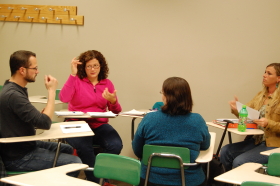
Half a dozen students wearing plain black shirts in pairs at two long tables in a room in Building 9. Fists bumps, fingers fly and hands wave as the students practice a silent language. Though their lips are moving, no words come out. They are learning not only a new language, but also a new culture.
American Sign Language students make up a unique subculture at Sinclair Community College, according to students and teachers involved in the four-year program. Liz Paul, a second-year ASL student, believes that relational bonds are created because students learn and struggle together.
“(We’re like) our own minority learning about a minority,” Paul said.
Robbin Hoopes, an ASL professor, said students are required to become both bilingual and bicultural in the ASL program. Students pick up social norms through regular interactions with the deaf community, such as visiting area “deaf clubs,” according to Hoopes. The subculture is developed when students interact together both during and outside of classes, he said.
One way that ASL students maintain their subculture is through the clothes they wear according to Paul. Students are required to wear shirts with print or design with colors opposite to their skin tone. When interrupting, they are required to wear all black, according to Paul. This is called “platform intelligence,” she said, and makes it easier to recognize signs.
Some classes are taught using only sign language according to Aimee Phillabaum, a first-year ASL student. It was one of the first things she noticed about her second sign language.
“It’s just diving in, head first,” Phillabaum said.
The biggest stereotype ASL students face is that interpreters help the deaf community, according to Paul, Phillabaum and Hoopes. They all stress how independent the deaf community is.
“They can’t hear, they’re not stupid,” Paul said.
Phillabaum said she likes how willing many deaf people are to help students learn to sign. Paul, who believes the deaf are discriminated against, said the deaf community is warm and welcoming to those who are willing to learn.
She recommends learning sign language.
